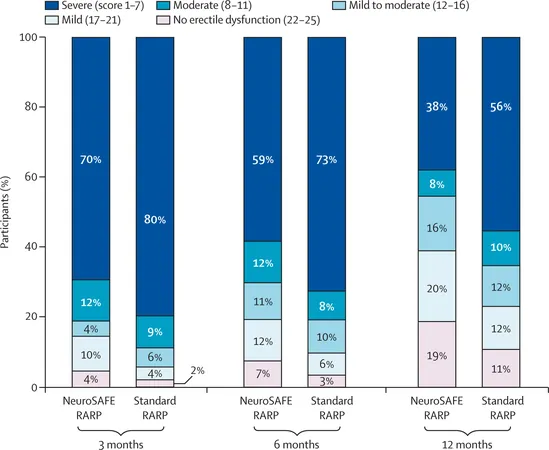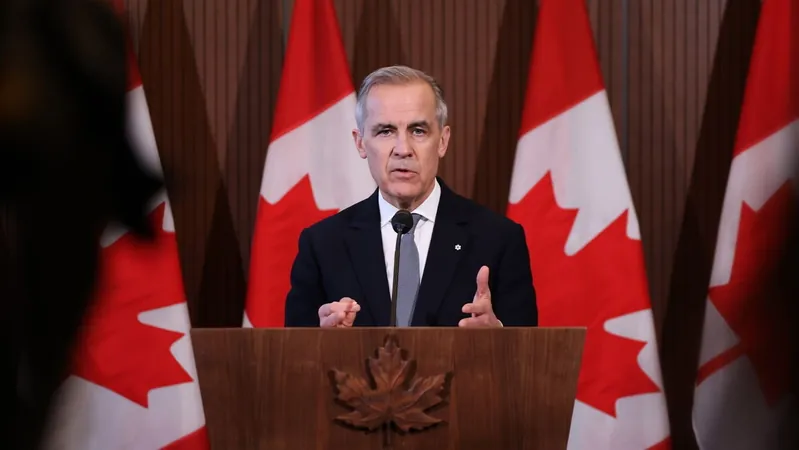
Revolutionary Surgery Technique Doubles Men's Chances of Keeping Erectile Function After Prostate Cancer Treatment!
2025-03-24
Author: Emma
Introduction
In a groundbreaking study, researchers from UCL and UCLH have unveiled a pioneering technique that drastically improves outcomes for men undergoing prostate cancer surgery. The NeuroSAFE method was found to enable almost twice as many men to retain their erectile function compared to those receiving traditional surgical approaches. These exciting findings were shared at the 2025 European Association of Urology (EAU) Congress in Madrid and published in The Lancet Oncology.
Background
Prostate cancer surgery can often lead to significant issues, including erectile dysfunction and urinary incontinence, which profoundly affect a patient's quality of life. The NeuroSAFE PROOF trial assessed the revolutionary technique designed to protect the vital nerves surrounding the prostate that are essential for sexual function during the removal of cancerous tissue.
How NeuroSAFE Works
This innovative method integrates an intraoperative evaluation to ensure all cancer cells are eliminated, allowing surgeons to preserve essential nerves without compromising the cancer removal's efficacy. While robotic surgery technologies have paved the way for nerve-sparing techniques in recent years, many surgeons still hesitate to utilize them during standard procedures to avoid the risk of leaving residual cancer behind.
Trial Findings
The NeuroSAFE technique addresses this uncertainty by providing real-time assessments during surgery. Professor Greg Shaw, the trial lead, highlighted that nearly double the number of men can avoid life-altering erectile dysfunction through the NeuroSAFE approach. He emphasized the technique's affordability and potential for maximizing patient well-being without risking cancer control.
Patient Suitability
While not suitable for every patient—particularly those who may opt for traditional nerve-sparing robotic methods—the NeuroSAFE technique offers hope for younger males and those otherwise deemed unsuitable for nerve-sparing options.
Trial Design & Results
The trial itself was a significant endeavor, taking place across five UK hospitals and marking the first randomized controlled study on the impact of NeuroSAFE on erectile dysfunction and urinary incontinence, two common side effects of prostate cancer surgery. In total, 344 men diagnosed with prostate cancer participated, effectively divided into two groups: one receiving the NeuroSAFE method and the other undergoing standard surgery.
Results were promising. Twelve months post-surgery, 39% of men in the NeuroSAFE group reported mild or no erectile dysfunction, compared to just 23% in the standard surgery cohort. Additionally, only 38% of those who underwent NeuroSAFE experienced severe erectile dysfunction after a year, whereas that figure soared to 56% for those with conventional surgery. Importantly, while NeuroSAFE did not significantly change the number of patients who regained urinary continence, those who did recover achieved this milestone more swiftly than their counterparts.
NeuroSAFE Technique Overview
The NeuroSAFE approach, which has been in practice for over ten years, still sees limited application outside of Germany where it originated. During the procedure, the prostate gland is removed while ensuring maximum preservation of surrounding nerve tissue. A unique aspect of this technique involves swiftly freezing the prostate for pathology analysis while surgery progresses. If cancer is detected near the nerve areas, additional tissue can be removed to guarantee complete cancer excision, albeit at the cost of sacrificing nerve preservation.
Expert Insights
Dr. Ricardo Almeida-Magana, who authored the study, noted that the NeuroSAFE method offers a clear advantage over standard procedures by providing certainty rather than guesswork about nerve preservation. This crucial advancement promises to widen the pool of men eligible for nerve-sparing surgery while still prioritizing cancer removal.
The significance of the NeuroSAFE development was echoed by Derya Tilki, a urology professor at the Martini Klinik Prostate Cancer Center in Hamburg. He stated that their center uses NeuroSAFE for a majority of their 2,500 prostate cancer cases annually and expressed optimism about the randomized trial validating its effectiveness. He also noted the importance of post-surgical penile rehabilitation in enhancing erectile function, providing an additional layer of treatment consideration.
Conclusion
While the current study did not explore long-term cancer outcomes, historical data spanning over 20 years suggests that the NeuroSAFE method does not negatively impact cancer control, further substantiating its viability as an essential surgical technique.
This remarkable advancement in prostate cancer treatment is not just a victory for medicine, but a beacon of hope for countless men facing the challenges of surgery and the potential side effects that could follow. As research continues, we may soon see more lives transformed by this technique on a global scale.









 Brasil (PT)
Brasil (PT)
 Canada (EN)
Canada (EN)
 Chile (ES)
Chile (ES)
 Česko (CS)
Česko (CS)
 대한민국 (KO)
대한민국 (KO)
 España (ES)
España (ES)
 France (FR)
France (FR)
 Hong Kong (EN)
Hong Kong (EN)
 Italia (IT)
Italia (IT)
 日本 (JA)
日本 (JA)
 Magyarország (HU)
Magyarország (HU)
 Norge (NO)
Norge (NO)
 Polska (PL)
Polska (PL)
 Schweiz (DE)
Schweiz (DE)
 Singapore (EN)
Singapore (EN)
 Sverige (SV)
Sverige (SV)
 Suomi (FI)
Suomi (FI)
 Türkiye (TR)
Türkiye (TR)
 الإمارات العربية المتحدة (AR)
الإمارات العربية المتحدة (AR)